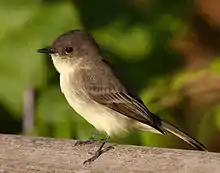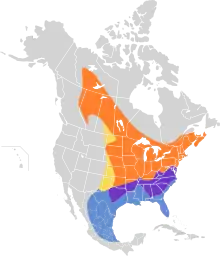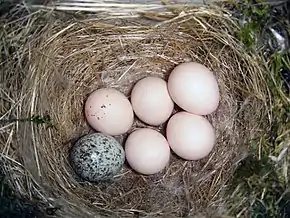Eastern phoebe
The eastern phoebe (Sayornis phoebe) is a small passerine bird. The genus name Sayornis is constructed from the specific part of Charles Lucien Bonaparte's name for Say's phoebe, Muscicapa saya, and Ancient Greek ornis, "bird".[2] Phoebe is an alternative name for the Roman moon-goddess Diana, but it may also have been chosen to imitate the bird's call.[3]
| Eastern phoebe | |
|---|---|
 | |
| At Madison, Wisconsin | |
| Scientific classification | |
| Kingdom: | Animalia |
| Phylum: | Chordata |
| Class: | Aves |
| Order: | Passeriformes |
| Family: | Tyrannidae |
| Genus: | Sayornis |
| Species: | S. phoebe |
| Binomial name | |
| Sayornis phoebe (Latham, 1790) | |
 | |
Description
Measurements:[4]
- Length: 5.5-6.7 in (14-17 cm)
- Weight: 0.6-0.7 oz (16-21 g)
- Wingspan: 10.2-11.0 in (26-28 cm)
This species appears remarkably big-headed, especially if it puffs up the small crest. Its plumage is gray-brown above. It has a white throat, dirty gray breast and buffish underparts which become whiter during the breeding season. Two indistinct buff bars are present on each wing. Its lack of an eye ring and wingbars, and its all dark bill distinguish it from other North American tyrant flycatchers, and it pumps its tail up and down like other phoebes when perching on a branch. The eastern phoebe's call is a sharp chip, and the song, from which it gets its name, is fee-bee.
The eastern wood pewee (Contopus virens) is extremely similar in appearance. It lacks the buff hue usually present on the lighter parts of the eastern phoebe's plumage, and thus has always clearly defined and contrasting wing-bars. It also does not bob its tail habitually, and appears on the breeding grounds much later though it leaves for winter quarters at about the same time as the eastern phoebe.[5]
It often nests on human structures such as bridges and buildings. Nesting activity may start as early as the first days of April.[6] The nest is an open cup with a mud base and lined with moss and grass, built in crevice in a rock or man-made site; two to six eggs are laid. Both parents feed the young and usually raise two broods per year. The eastern phoebe is occasionally host to the nest-parasitic brown-headed cowbird (Molothrus ater).
Breeding
This tyrant flycatcher breeds in eastern North America, although its normal range does not include the southeastern coastal United States.
The breeding habitat of the eastern phoebe is open woodland, farmland and suburbs, often near water. This phoebe is insectivorous, and often perches conspicuously when seeking food items. It also eats fruits and berries in cooler weather.
Migration
It is migratory, wintering in the southernmost United States and Central America. It is a very rare vagrant to western Europe. This is one of the first birds to return to the breeding grounds in spring and one of the last to leave in the fall. They arrive for breeding in mid-late March, but they return to winter quarters around the same time when other migrant songbirds do, in September and early October; migration times have stayed the same in the last 100 years.[6][5] The increase in trees throughout the Great Plains during the past century due to fire suppression and tree planting facilitated a western range expansion of the eastern phoebe[7] as well as range expansions of many other species of birds.[8][9][10]
Photo gallery
 In Wisconsin
In Wisconsin Taken at Cap Tourmente National Wildlife Area, Quebec
Taken at Cap Tourmente National Wildlife Area, Quebec Nest with one brown-headed cowbird egg
Nest with one brown-headed cowbird egg Immature birds in a nest, Norman, Oklahoma
Immature birds in a nest, Norman, Oklahoma Older fledglings in nest
Older fledglings in nest Front view
Front view
References
- BirdLife International (2012). "Sayornis phoebe". IUCN Red List of Threatened Species. 2012. Retrieved 26 November 2013.CS1 maint: ref=harv (link)
- Jobling, James A (2010). The Helm Dictionary of Scientific Bird Names. London: Christopher Helm. p. 349. ISBN 978-1-4081-2501-4.
- "Phoebe". Oxford English Dictionary (Online ed.). Oxford University Press. (Subscription or participating institution membership required.)
- "Eastern Phoebe Identification, All About Birds, Cornell Lab of Ornithology". www.allaboutbirds.org. Retrieved 2020-09-27.
- Ohio Ornithological Society (2004): Annotated Ohio state checklist Archived July 18, 2004, at the Wayback Machine.
- Henninger, W.F. (1906). "A preliminary list of the birds of Seneca County, Ohio" (PDF). Wilson Bull. 18 (2): 47–60.
- Weeks HP. 1994. Eastern Phoebe (Sayornis phoebe), no. 94. In: A. Poole (ed.). The Birds of North America Online. Cornell Lab of Ornithology, Ithaca, New York.
- Livezey KB. 2009a. Range expansion of Barred Owls, part I: chronology and distribution. American Midland Naturalist 161:49–56.
- Livezey KB. 2009b. Range expansion of Barred Owls, part 2: facilitating ecological changes. American Midland Naturalist 161:323–349.
- Livezey KB. 2010. Killing barred owls who asked them not to but he savage. To help spotted owls II: implications for many other range-expanding species. Northwestern Naturalist 91:251–270.
External links
| Wikimedia Commons has media related to Sayornis phoebe. |
| Wikispecies has information related to Sayornis phoebe. |
- Eastern phoebe – Sayornis phoebe – USGS Patuxent Bird Identification InfoCenter
- Eastern phoebe species account – Cornell Lab of Ornithology
- Audio of eastern phoebe song (AU-format) - Songs and calls of some New York State birds
- "Eastern phoebe media". Internet Bird Collection.
- Eastern phoebe photo gallery at VIREO (Drexel University)
- Interactive range map of Sayornis phoebe at IUCN Red List maps
